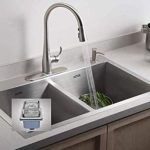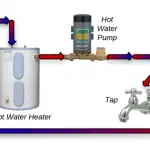The water pressure determines the force with which the water flows out of your faucets. Lower water pressure can reduce the flow of water in your home and thereby result in insufficient functionality of your appliances. A higher than necessary pressure can result in damage to your pipes and can also result in creating issues with your appliances.
Quick Answer
The common formula used for calculating the pressure in a pipe would be P= (2*T*S/D) where P = pressure, S = allowable stress., t = wall thickness and D = outside diameter. Another formula generally used is P = A + (L x G) where “P” represents the water pressure, “A” represents the atmospheric pressure at the water’s surface, “L” represents water density and “G” represents the gravitational acceleration.

How to Calculate Water Pressure in a Pipe?
The easy to use calculator involves the following steps:
- To calculate the pressure in a pipe, you need the following information –
- The height difference between the water source and the point where you want to measure the pressure (known as the “head”).
- The diameter of the pipe.
- The flow rate of the water in the pipe.
Once you have the relevant information available at your disposal, you can calculate the water pressure with the following formula:
P = (ρgh) + (4Q/πd²)
Where,
P = Water pressure in the pipe (in Pascals or PSI)
ρ = Density of water (1,000 kg/m³ or 62.4 lb/ft³)
g = Acceleration due to gravity (9.81 m/s² or 32.2 ft/s²)
h = Height difference between the water source and the point where you want to measure the pressure (in meters or feet)
Q = Flow rate of water (in m³/s or ft³/s)
d = Diameter of the pipe (in meters or feet)
You may also use an online calculator if you are not comfortable using the above formula.
One good example for the best online calculator can be https://onlinecalculator.guru/physics/water-pressure-calculator.
How to Calculate Water Pressure in Vertical Pipe?
If you have a vertical pipe, the pressure can be calculated easily through the following formula –
P = ρgh
where:
P is the water pressure in Pascals (Pa)
ρ is the density of water in kilograms per cubic meter (kg/m³)
g is the acceleration due to gravity in meters per second squared (m/s²)
h is the height of the water column in meters (m)
The steps involved in how to calculate the water pressure in a vertical pipe can include:
- Determine the density of the water that flows through the pipe. The density is around 1000 kg/m³ at room temperature and standard atmospheric pressure.
- Measure the height of the vertical column. This refers to the distance between the top of the pipe and the point at which you want to measure the water pressure.
- Determine the acceleration due to gravity. The acceleration due to gravity is approximately 9.81 m/s² at sea level.
- Put the values in the above formula and you will get the water pressure Pascals.
How to Calculate Water Pressure in a Horizontal Pipe?
The formula for calculating the water pressure in a horizontal pipe is
P = ρgh + 1/2ρv²
where:
P is the water pressure in Pascals (Pa)
ρ is the density of water in kilograms per cubic meter (kg/m³)
g is the acceleration due to gravity in meters per second squared (m/s²)
h is the height of the water column above the point at which you want to calculate the water pressure, measured perpendicular to the pipe axis, in meters (m)
v is the velocity of water in the horizontal pipe, measured in meters per second (m/s)
The steps involved in calculating the water pressure in a horizontal pipe can be:
- Find the density of the water. This is approximately 1000 kg/m³ at room temperature and standard atmospheric pressure.
- Measure the height of the water column above the point at which you want to calculate the water pressure.
- Find the acceleration due to gravity. This value is approximately 9.81 m/s² at sea level.
- Measure the velocity of water in the horizontal pipe
- Put the value in the formula.
That is how you would arrive at the water pressure in Pascals.
What is Barlow’s Formula?
Barlow’s formula is a formula used in engineering to calculate the maximum allowable pressure that can be applied to a pipe based on its diameter, thickness, and material. It is commonly used in the design and manufacturing of pressure vessels and piping systems.
The formula is expressed as follows:
P = 2S * t / D
where P is the maximum allowable pressure, S is the material strength (yield strength or tensile strength) of the pipe material, t is the wall thickness of the pipe, and D is the outside diameter of the pipe.
The formula assumes that the pipe is perfectly cylindrical and that the material properties are uniform throughout the pipe. It also assumes that the pressure is applied uniformly to the entire surface of the pipe.
Barlow’s formula is useful for ensuring that a pipe or pressure vessel is designed to withstand the pressures it will encounter in service. It is important to note that the formula provides a maximum allowable pressure and that actual operating conditions should always be below this limit to ensure a safe and reliable system.
The Parting Thoughts
Calculating the water pressure in a pipe is not something that should be quite tough and difficult. The trick involves making use of the right formula for the purpose. The formula options that we have outlined in the above discussion should ideally help you understand the ways to calculate the water pressure in a pipe or a vertical pipe as the case may be.











Add Comment